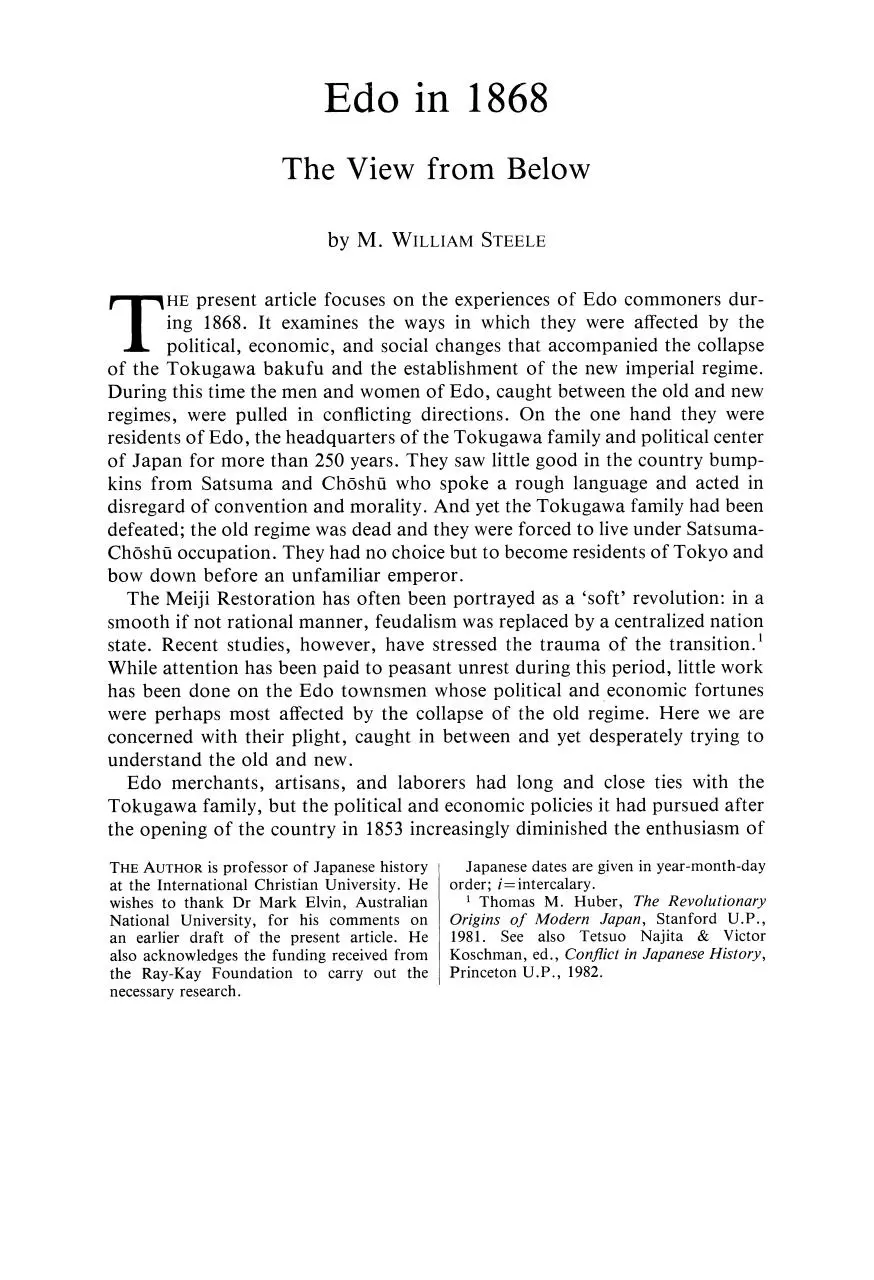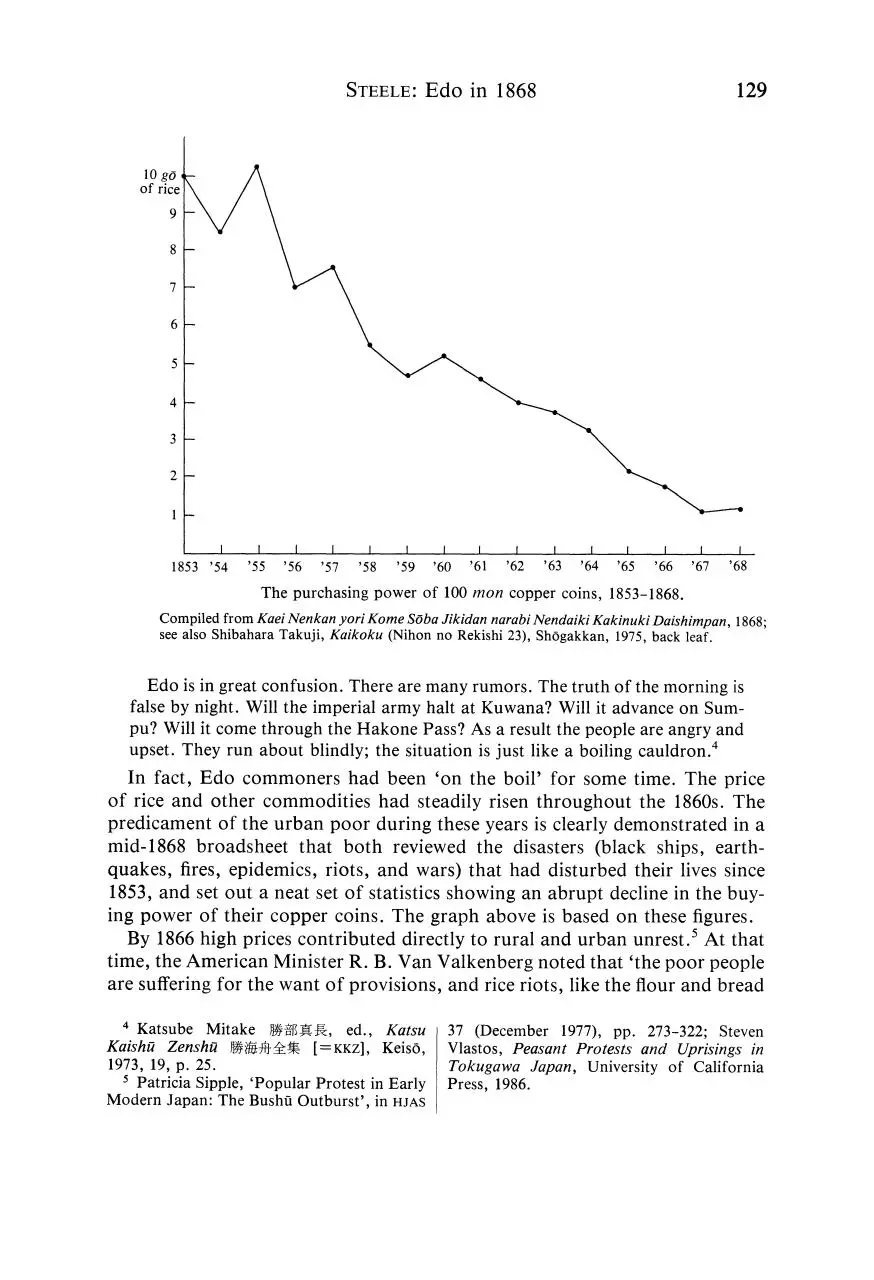edo in 1868 (1) (PDF)
File information
This PDF 1.4 document has been generated by Prawn, and has been sent on pdf-archive.com on 17/11/2015 at 21:29, from IP address 129.128.x.x.
The current document download page has been viewed 982 times.
File size: 5.52 MB (30 pages).
Privacy: public file





File preview
Edo in 1868. The View from Below
Author(s): M. William Steele
Source: Monumenta Nipponica, Vol. 45, No. 2 (Summer, 1990), pp. 127-155
Published by: Sophia University
Stable URL: http://www.jstor.org/stable/2384846
Accessed: 16-11-2015 21:47 UTC
Your use of the JSTOR archive indicates your acceptance of the Terms & Conditions of Use, available at http://www.jstor.org/page/
info/about/policies/terms.jsp
JSTOR is a not-for-profit service that helps scholars, researchers, and students discover, use, and build upon a wide range of content
in a trusted digital archive. We use information technology and tools to increase productivity and facilitate new forms of scholarship.
For more information about JSTOR, please contact support@jstor.org.
Sophia University is collaborating with JSTOR to digitize, preserve and extend access to Monumenta Nipponica.
http://www.jstor.org
This content downloaded from 129.128.216.34 on Mon, 16 Nov 2015 21:47:14 UTC
All use subject to JSTOR Terms and Conditions
Edo in 1868
The View fromBelow
T
by M. WILLIAM STEELE
durof Edo commoners
NHE presentarticlefocuseson theexperiences
ing 1868. It examines the ways in which they were affectedby the
political,economic,and social changesthataccompaniedthe collapse
of the Tokugawa bakufu and the establishmentof the new imperialregime.
Duringthistimethemen and womenof Edo, caughtbetweentheold and new
regimes,were pulled in conflictingdirections.On the one hand theywere
residentsof Edo, theheadquartersof theTokugawa familyand politicalcenter
of Japan formorethan 250 years.They saw littlegood in the countrybumpkins fromSatsuma and Choshfuwho spoke a rough language and acted in
disregardof conventionand morality.And yettheTokugawa familyhad been
defeated;theold regimewas dead and theywereforcedto liveunderSatsumaChoshtuoccupation.Theyhad no choicebutto becomeresidentsof Tokyo and
bow down beforean unfamiliaremperor.
The Meiji Restorationhas oftenbeen portrayedas a 'soft' revolution:in a
smoothif not rationalmanner,feudalismwas replacedby a centralizednation
state. Recent studies, however,have stressedthe trauma of the transition.'
Whileattentionhas been paid to peasant unrestduringthisperiod,littlework
has been done on the Edo townsmenwhose politicaland economicfortunes
were perhaps most affectedby the collapse of the old regime.Here we are
concernedwiththeirplight,caughtin betweenand yet desperatelytryingto
understandthe old and new.
Edo merchants,artisans,and laborers had long and close ties with the
Tokugawa family,but thepoliticaland economicpoliciesit had pursuedafter
diminishedthe enthusiasmof
the openingof the countryin 1853 increasingly
THE AUTHOR is professorof Japanesehistory
at the InternationalChristianUniversity.He
wishes to thank Dr Mark Elvin, Australian
National University,for his comments on
an earlier draft of the present article. He
also acknowledgesthe fundingreceivedfrom
the Ray-Kay Foundation to carry out the
necessaryresearch.
Japanesedates are givenin year-month-day
order; i=intercalary.
1 Thomas M. Huber, The Revolutionary
Origins of Modern Japan, Stanford U.P.,
1981. See also Tetsuo Najita & Victor
Koschman,ed., Conflictin JapaneseHistory,
PrincetonU.P., 1982.
This content downloaded from 129.128.216.34 on Mon, 16 Nov 2015 21:47:14 UTC
All use subject to JSTOR Terms and Conditions
128
MonumentaNipponica, 45:2
theirsupport.Theyrealizedthatthebakufuwas unableto wardofftheforeign
barbarians.2The Tokugawa familyseemedhelplesseitherto protectthecountryfromforeigninvasionor to providethe basis fordomesticlaw and order.
By 1868 Edo commonershad become disenchantedwithTokugawa rule.
On theotherhand theywereambivalent,ifnot opposed, to thenewimperial
systemand the politicaldesignsof the men fromSatsuma and Choshui.They
weredismayedbythenewsof thedefeatof Tokugawa forcesat Toba-Fushimi
duringthe firstweek of the new year, 1868. They feared for theircityas
imperialtroops advanced on and finallyoccupied Edo in the spring.Many
townsmenactivelysupportedthe resistanceactivitiesof the Shogitai#A4z
(a band of youngpro-Tokugawadiehards)and otheranti-imperial
forces;certainlytheylamentedthe defeatof the Sho5gitai
on 1868.5.15. By late summer
theyweretold thattheircitywas to be renamedTokyo, the EasternCapital,
and finallyin the autumn,on 10.11, theywere forcedto bow down to the
boy emperor.A worldhad passed, but fora briefmomentthe social lid was
liftedto allow a unique glimpseinto some of the bottom-layer
attitudesand
propensitiesof the Edo commoners.
Naturallythesourcesavailable forresearchon late Tokugawa social history
are limited.Commonerswerenot concernedto writedown theirpoliticaland
social viewsin anycoherentfashion.A hodgepodgeof documentary
evidence,
however,is available: diaries, petitions,inflammatory
statements,mocking
rhymes,satiricalcartoons,kabukiplays,popular literature,
crudenewspapers
(both Japaneseand Western),broadsheets,handbills,and evengraffiti.
In adKatsu
Kaishfi
the
dition,
Tokugawa retainerwho playeda leadingrole
WV4,
in mediatinga settlementbetweenthe formerbakufu and the new imperial
regime,lefta diarydetailingthe eventsof 1868. As he was particularlysympatheticto the plightof the common people and oftenrecordedhis impressions of social conditionsin Edo, the diaryis especiallyhelpfulin helpingus
understandhow the commonersexperiencedthe Restoration.'
A BoilingCauldron
On 1868.19.2, as the imperialarmywas makingits advance on Edo, Katsu
Kaishfusummedup the situationin Edo as follows:
2 M. William Steele, 'Goemon's New
World View: Commoner Representationsof
the Opening of Japan', in Asian Cultural
Studies, 17 (1989), pp. 69-83.
3 Major sources for bakumatsu social
historyinclude Sakuragi Sho
, Sokumenkan Bakumatsu-shi I
Godo,
& Koike Sho1975; Suzuki Tozo6
taro
6Jvffitc13, ed., Kinsei Shomin Seikatsu
4:
Shiryo: Fujiokaya Nikki
jt o
NP1W H6E, San'ichi, 1987- (10 volumes
planned); Suzuki Tozo & Okada Satoshi 0I M
1
,- Tokyodo, 1985, 3 vols.; and Yoshino
Masayasu -JAf , Kaei Meiji Nenkanroku
m ,tic
W i 8-ii
Gannando, 2 vols., reprint,
1968.
Secondary sources include Minami Kazuo
4i
f- , Ishin Zen'ya no Edo Shomin l-%NihslfR
1 wIP , Kyoikusha, 1980, and Yoshihara
Ken'ichiro lV R NS, Edo no Johoya:
c' -1F
BakumatsuShomin-shino Sokumen i1 CO
cJ
NHK Books, 1978.
tgW g t
f18HIJL,
j4t,ed., Edo JidaiRakushoRuiju i-i X
This content downloaded from 129.128.216.34 on Mon, 16 Nov 2015 21:47:14 UTC
All use subject to JSTOR Terms and Conditions
STEELE:
Edo in 1868
129
10 g0_
of rice
9
8
7
6
5
4
3
2
l
1853 '54
l
l
'55
'56
l
'57
l
l
I
,
I
'58
'59
'60
'61
'62
,
'63
,
'64
,
'65
,
'66
l
'67
'68
The purchasingpower of 100 mon copper coins, 1853-1868.
CompiledfromKaei NenkanyoriKome Soba JikidannarabiNendaikiKakinukiDaishimpan,1868;
see also Shibahara Takuji, Kaikoku (Nihon no Rekishi23), Shogakkan, 1975, back leaf.
Edo is ingreatconfusion.
Therearemanyrumors.
Thetruth
ofthemorning
is
falsebynight.Willtheimperial
armyhaltat Kuwana?Willitadvanceon Sumpu? Willitcomethrough
theHakonePass? As a resultthepeopleareangryand
upset.Theyrunaboutblindly;thesituation
is justlikea boilingcauldron.4
In fact,Edo commonershad been 'on the boil' for some time. The price
of rice and othercommoditieshad steadilyrisenthroughoutthe 1860s. The
predicamentof the urban poor duringtheseyearsis clearlydemonstrated
in a
mid-1868 broadsheet that both reviewedthe disasters(black ships, earthquakes, fires,epidemics,riots,and wars) thathad disturbedtheirlives since
1853, and set out a neat set of statisticsshowingan abruptdeclinein thebuying power of theircopper coins. The graphabove is based on thesefigures.
By 1866 highpricescontributeddirectlyto ruraland urbanunrest.5At that
time,theAmericanMinisterR. B. Van Valkenbergnotedthat'thepoor people
are suffering
forthewantof provisions,and riceriots,liketheflourand bread
4 Katsube
Mitake
)W
Kaishu Zenshiu O49:t{
1973, 19, p. 25.
A-, ed., Katsu
[=KKZ], Keiso,
5 Patricia Sipple, 'Popular Protestin Early
Modern Japan: The BushfiOutburst',in HJAS
37 (December 1977), pp. 273-322; Steven
Vlastos, Peasant Protests and Uprisingsin
Tokugawa Japan, Universityof California
Press, 1986.
This content downloaded from 129.128.216.34 on Mon, 16 Nov 2015 21:47:14 UTC
All use subject to JSTOR Terms and Conditions
130
MonumentaNipponica, 45:2
riotsof morecivilizedcountries,are frequent.Mobs at timeshave paradedthe
streetsbreakinginto ricewarehouses,and committing
othercrimesattendant
upon such emutesof thepeople.'6 In factEdo had suffered
frommajor bouts
of mob violence,beginningin 1866.5. Rice shops,pawn shops,sakeshops,and
of merchantswho profitedfromforeigntradewereraided
the establishments
and wrecked.7
on the Tokugawa
People werequick to place the blame fortheirsufferings
government.
In late 1866a piece of graffiti
was foundpastedon thedoor of the
citycommissioner'soffice:'Owing to high prices,goods are in shortsupply
and able officialsare all sold out.'8 Katsu also ascribedthe social discontent
of 1866 to a failureof bakufu leadership.In his diary he predictedthat if
administrativereformswere not instituted,rural and urban unrestwould
spell the end of Tokugawa rule.9
Edo commonerswerenot only aware of the economicills of theirsociety;
theywerekeenobserversof thepoliticalsceneas well.An unsignedwoodblock
of the political
printissued in 1867.3 is good evidenceof theirunderstanding
problemsof the day. Titled 'TreatingDifficultDiseases', the printportrays
a situation where patients (political leaders) seek cures for ratherstrange
diseases. The daimyo of Satsuma, for example, suffersfromthe 'long-arm
disease'. In thecaptionhe says: 'In thisconditionI seemalwaysto be wanting
thingsthatbelongto others.What am I to do? Please don't letme die.' Other
daimyoare similarlyinflictedby raremaladies: the 'show-only-your-backside
disease', the 'no-backbone disease', the 'no-face disease', the 'mouth-only
disease', and so on. Tokugawa Keiki (or Yoshinobu) S)I11 5', who was
fromdepressionbroughton by the
appointedshogunin 1866.12, is suffering
of
fetters his office.He is made to say, 'If only I could retireand turnover
thesebothersomedutiesto my son.'
While the printis a humorouslook at the problemsof the politicalelite,it
also portraysa profoundcynicismfeltbythecommonerstowardtheirsamurai
masters.The people were concernedabout but also criticalof the failureof
theirleadersto save themfromeconomicand politicalconfusion.As theprint
itselfnotes: 'The famousdoctorwho acceptedthesepatientsalso gave up.'10
Any hope that the new head of the Tokugawa familywould come to the
6
Dispatch from Mr. Van Valkenbergto
Secretaryof State, dated 5 November1866.
Papers Relatingto ForeignAffairs,AccompanyingtheAnnual Message of thePresident
to theSecond Session Thirty-Ninth
Congress,
Government Printing Office, Washington,
1867, 2, pp. 226-27.
7 For the details, see the chapter on the
1866 Edo riotingin Minami Kazuo, BakumatsuEdo Shakai no Kenkyii
aI)t=a
Wt, Yoshikawa, 1978,pp. 266-324. Minami,
Ishin Zen'ya, pp. 147-58, summarizesthis
chapter.
8 Quoted in
Minami,Ishin Zen'ya, p. 157.
9 Zoku Saimu Kijii
Nihon
ShisekiKyokai, 1922, 5, pp. 132-33.
10 MinamiKazuo has analyzedthisprintin
Ishin Zen'ya, p. 190. A copy of the original
printmaybe foundin theShiryohensanjoCollection,Universityof Tokyo.
Othercollectionsof late Tokugawa popular
printsare preservedin the Tokyo Municipal
Library (Tokyo Toritsu Toshokan) and the
National Museum of Japanese History(KokuritsuRekishiMinzoku Hakubutsukan).
This content downloaded from 129.128.216.34 on Mon, 16 Nov 2015 21:47:14 UTC
All use subject to JSTOR Terms and Conditions
STEELE:
*. ..
.....
...
. &
:
........:
.
..
131
Edo in 1868
-
TokyoUniversity.
Shiryohensanjo,
'TreatingDifficultDiseases.
rescueof theEdo commoners
was confounded
by hispetitionof 1867.14.10
forpermission
to return
politicalauthority
to theemperor(taiseihokan7k*
declared
s) The newscaused havoc in Edo; some Tokugawaretainers
themselves
readyto carryouta coupagainstKeiki.l Thecommoners,
already
suspiciousof hiswell-known
infatuation
withthingsWestern,
concludedthat
Keikifeltno concernfortheirsafety
andwelfare.
A mocking
rhyme
popularin
late1867condemned
Keikias an 'evilking'.12Atthesametimetheresidents
of
Edo werebuffeted
by a rashof murders,
and otheractsof terror.
robberies,
Beginning
in late 1867.10and continuing
wellintospringof 1868,gangsof
hoodlumsroamedthestreets
ofEdo, destroying,
as faras thecommoners
were
anysemblanceof law and order.Whilesomeof thelootingwas
concerned,
donebytheEdo poor,muchof it can be attributed
to Satsumamen,someof
whom,it wassaid,hadbeensentbySaigoTakamorigW4Wihimself.
Satsuma
roniniRX,callingthemselves
the 'SatsumaAdvanceGuardof theImperial
Army'(KangunSempoSasshu-han
'8gSi)Il'l)
wereclearly
responsible
forsetting
firesand instigating
riots.On theone handtheyurgedthepeople
to rebelagainsttheevilTokugawaauthorities,
andon theotherwarnedthem
l Shibusawa Eiichi R
S8;5R;toD
et
HE, in Kyoto
Tokugawa K5do' g>
Keiki-ko Den 4 1IIFXfi~, Toyo Bunko re- DaigakuKyoikuGakubuKiyoegW tPM
print,1968, 3, pp. 256-57.
IVEO, 30 (1984), p. 18. The originalsourceis
12 Quoted in MotoyamaYukihiko*[1A,
Sokumenkan
Bakumatsu-shi,
2, p. 763.
'Bakumatsu ni okeru Minshu no Ishiki to
This content downloaded from 129.128.216.34 on Mon, 16 Nov 2015 21:47:14 UTC
All use subject to JSTOR Terms and Conditions
132
MonumentaNipponica, 45:2
to fleein orderto escapeinjuryin theupcoming
civilwar.One oftheirhandbillsdeclared:
In recentyearsevilofficials
of thebakufuhaveignoredcourtauthorities,
made
pactswithWestern
barbarians,
slighted
thecourt,and destroyed
thepropriety
betweenlordand vassal.Therefore
thegreatlordsof thewestern
domainsare
in orderto eradicatetheevilbakufuofficials.
cooperating
theshogun
Although
hasreturned
politicalauthority
to thethroneandis nowsimply
oneofthelords,
in theKantoignorethis.Theysecretly
evilofficials
plothowto graspauthority
onceagain.Therefore
we proposethegreatplanthatall determined
menin the
nationgathertogether
on 11.4 and forma 'heavenlyarmy'[tempeiI4] to
burnEdo Castleand setfiresthroughout
Edo cityand punishtheevilofficials.
Theonlythingthatweareafraidofis thatthepeoplemaysuffer
becauseofthis.
You shouldquicklymoveyourbelongings
and changeyourresidence
to avoid
harm.We do notintendto harmthepeople,onlyto savethem.13
Edo commoners
wereyettoturnto Satsumaforsalvation.Frenzieddancing
to theshoutofEeja naika,eeja naika ('Ain'titgreat!Ain'titgreat!')providedsomeoutletfortheirfrustrations.
The crazehitEdo inthe12thMonth,
justatthetimewhentroopsfromSatsuma,Choshu,Hizen,andTosa seizedthe
imperialpalace gatesin Kyoto,declaredan imperialrestoration
(oseifukko
abolishedtheTokugawabakufu.14
T_AY), and formally
Edo UnderSiege
Newsofthe1867.12.9coupd'etataddedto thegeneralstateofalarmthatexistedin Edo. TroopsfromShonaiand theShinchogumi
ViR6a,a Tokugawa
inan attempt
to restore
policeforcecomposedlargely
ofronin,
wereemployed
law and order,butto no avail. Earlyin themorning
of 12.23theNinomaru
of PrincessSeikan-int
palacewentup in flames.As it was theresidence
PrincessKazu Tl,widowof theshogunTokugawalemochi#,)II*j
(formerly
and auntof theMeiji emperor)and Tensho-ini
(widowof Tokugawa
lesada #)IIt and adopteddaughter
of ShimazuNariakira
) rumors
ascribedtheconflagration
threatened
to
to Satsumaronin
whohadpreviously
forcesinEdo
liberate
theseladiesfromEdo. Two dayslaterthepeace-keeping
tooktheirrevenge:theSatsumaresidence
was burntto theground.
Commoners
mayhaverejoicedwhentheSatsuma'hoodlums'weredriven
out of Edo, but theirhappinesswas short-lived.
News of the defeatof
Tokugawaarmiesat Toba-FushimireachedEdo on 1868.1.12.Tokugawa
Keikihad beendeclaredan 'enemyofthecourt'and an armyof chastisement
was soon directedagainstEdo.
Keiki'sflight
backto Edo becamethesubjectofpopularridicule.Leavingin
taken
thedeadofnightand losingtheirwayat sea, Keiki'sentourage
wasfirst
13
Teibo Zatsushiuroku
TYMM,
Nihon Richard Minear, 'In Pursuit of the Millen-
ShisekiKyokai, 1923, 1, p. 104.
14 For the Ee ja nai ka movement, see
nium', in Najita & Koschman,pp. 177-94.
This content downloaded from 129.128.216.34 on Mon, 16 Nov 2015 21:47:14 UTC
All use subject to JSTOR Terms and Conditions
STEELE:
-4
Edo in 1868
133
~'R
WE'Se-~~~~~~~~~~
)
.:J~~~~~~~~~~~~~~~~~~~
..... ...
.2~~~~~~~~~~~~~~~>~~~
.~~~~~~:;.....~~~~~~~~~~.
....
'The Toba Battleof Farts.'
Author's collection
aboard an Americanwarshipbeforebeing transferred
to the Kaiyo Maru mfl
V-,L.A mockingrhymein Edo clearlylabeled hima coward: 'He came back in
flight,afraid to fight,leaving his men behind.'15On the other hand, Edo
commonerswere hardlysympatheticwith the imperialcause. One satirical
cartoonsold on thestreetsof thecityin thespringof 1868ascribedtheimperial
victoryat Toba-Fushimito superiorfartingpower.
Immediatelyfollowingthedefeatof theTokugawa forcesat Toba-Fushimi,
an imperialdecreechargedKeiki withtreasonand urgedan immediateattack
upon his domains. A forceof some 50,000 men leftKyoto on 2.11. It made
rapid progressand by 3.5 the main forcehad reached Sumpu Castle, where
headquarterswereestablishedforthe finalstagesof the siege on Edo.
Excitementamong the people of Edo increasedas the imperialarmydrew
closer. It was difficult
to understandKeiki's policyof submission.On 2.11, the
same day thatimperialtroopsleftKyoto, Keiki announcedthathe was going
into domiciliaryconfinement
at Daiji-in ?2TS in the precinctsof Kan'eiji tI4
# at Ueno. The decision was not generallyliked; popular lampoons called
Keiki a coward and manyTokugawa troopschose to decamp. Katsu Kaishui,
Keiki's choice of mediatorwiththe imperialregimeand de factocommander
15
SokumenkanBakumatsu-shi,2, p. 776.
This content downloaded from 129.128.216.34 on Mon, 16 Nov 2015 21:47:14 UTC
All use subject to JSTOR Terms and Conditions
134
Monumenta Nipponica, 45:2
of the Tokugawa military,was forcedto cope both withinstitutionalbreakdown and popular discontent.His diaryof 2.1 notes:
At presenta successionof boats filledwiththe troopsdefeatedat TobaFushimiis arriving
in Edo.... Theyare disgruntled
byshortages
of foodand
lackofshelter.
Moreover,
theyareangeredbyinsufficient
pay.Theyareforming
secretbandsand decamping.... The townsmen
are dailymoredistressed
and
suspicious.Officials
repeatedly
orderincreases
infinancial
contributions
without
specific
purposesin mind.... Evenifenemytroopsdo notcome,itwillnotbe
longbeforeEdo collapsesfromwithin.16
Troop desertions,pro-waragitation,threatsof assassination,werebut the
beginningof theproblemsKatsu and otherTokugawa authoritiesfacedduring
the earlymonthsof 1868. Maintainingpublic orderin Edo and the surrounding countrysidewas the greatestchallenge.As the imperialarmyadvanced
on Edo and existingTokugawa institutionsof governmentcollapsed, Edo
commonersand theircountrycousins became increasingly
insecure.Peasant
riotingin the villagessurroundingEdo reacheda peak duringthistime,adding to an overridingsense of doom withinthe city.
The citycommissionersissued decreeafterdecreein an attemptto restorea
sense of security.Katsu also sanctionedthe use of bands of pro-Tokugawa
activistsin peacekeepingfunctions.The attemptwas to kill two birds with
one stone:to restorepublicorderin Edo and thesurrounding
and
countryside,
to assertcontrolover potentialsources of insurrection.To this end, Kondo
Isami's B% Shinchogumi,renamedthe ChimbutaiA ,_ or 'Pacification
Squad', was sentintotheMusashi and Kozuke regionswithordersto suppress
peasant rioting.WithinEdo, membersof the Shogitaiwereorderedto patrol
the streetsat night.
These measuresproved unsuccessful.Thieves and bullieshad virtualcommand of the citystreets.The Tokugawa police forcewas powerless;whenthe
imperialcommandoccupied Edo earlyin the 4thMonth,it had been reduced
to a mereforty-two
men.17 As Katsu confidedin his diary:
inEdo, beginning
withthevariousdaimyoandhatamoto
Recently
residences,
people are in the streetsnightand day cartingtheirbelongings
out to the
As a resultseveralthousandpeopleare rushing
countryside.
about,as though
at a fire,payingno heedto laws,howeverrepeatedly
theymaybe issued.For
the mostpart,hatamotoare returning
to theirestatesor hidingout in the
close to Edo. Takingadvantageof the situation,robbershave
countryside
18
and are stealingvaluablesand molesting
appearedeverywhere
women.
16 KKZ, 19, p. 12.
17 Tokyo Hyakunen-shi
HenshuiIinkai,ed.,
Tokyo Hyakunen-shi,
1973-1984, 2, p. 39.
18 KKZ,
19, p. 36.
Tokyo-to,
This content downloaded from 129.128.216.34 on Mon, 16 Nov 2015 21:47:14 UTC
All use subject to JSTOR Terms and Conditions
Download edo in 1868 (1)
edo_in_1868 (1).pdf (PDF, 5.52 MB)
Download PDF
Share this file on social networks
Link to this page
Permanent link
Use the permanent link to the download page to share your document on Facebook, Twitter, LinkedIn, or directly with a contact by e-Mail, Messenger, Whatsapp, Line..
Short link
Use the short link to share your document on Twitter or by text message (SMS)
HTML Code
Copy the following HTML code to share your document on a Website or Blog
QR Code to this page

This file has been shared publicly by a user of PDF Archive.
Document ID: 0000315533.